
Chapter 8. Genes to Proteins
8.1 Introduction

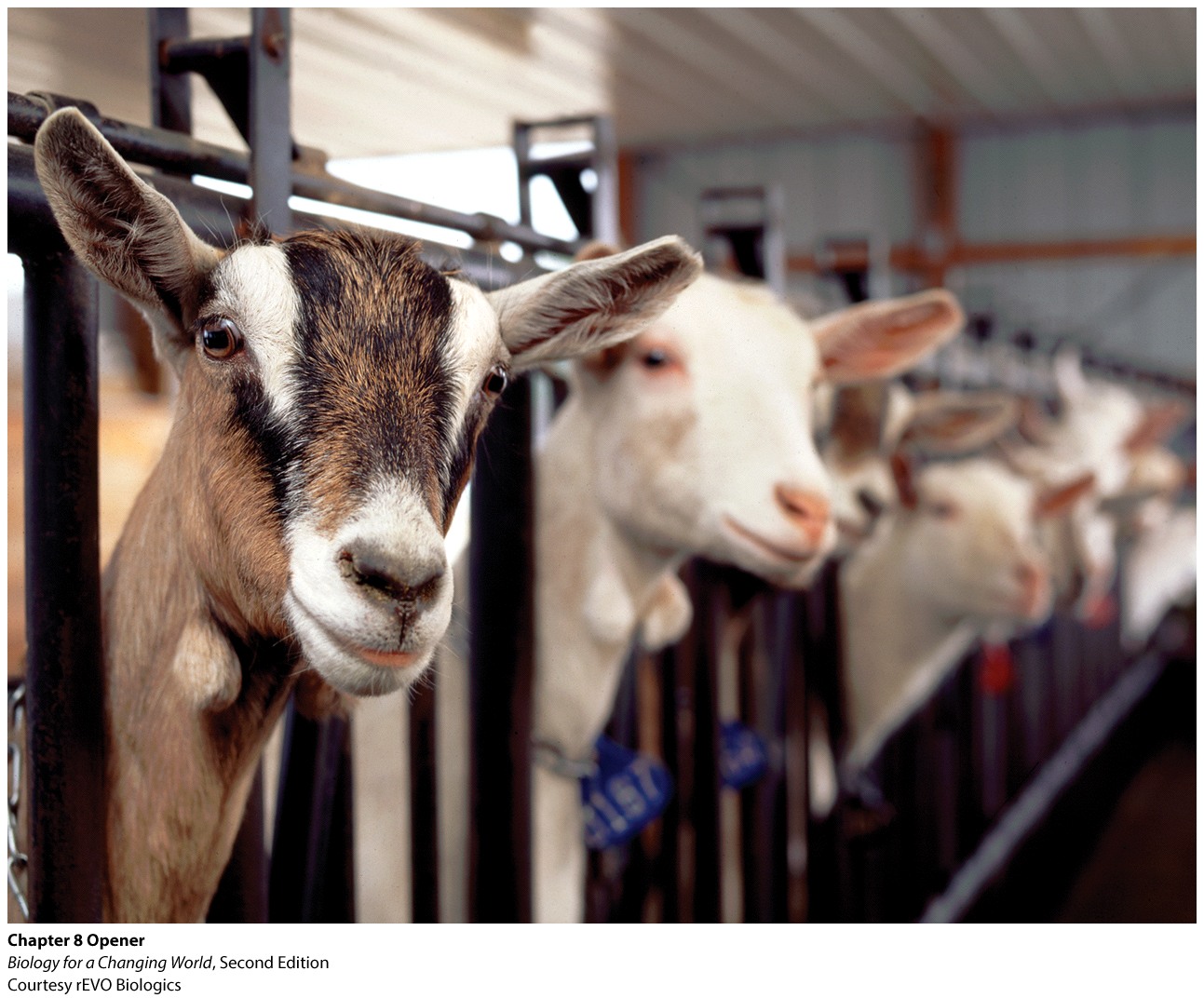
Welcome to the Interactive Study Guide for Chapter 8: Genes to Proteins! This Study Guide will help you master your understanding of the chapter's Driving Questions, using interactive Infographics and activities, as well as targeted assessment questions. Click "Next" to get started, or select a Driving Question from the drop-down menu to the right.
Medicine From Milk:
Scientists genetically modify animals to make medicine
DRIVING QUESTIONS
- What determines the shape of a protein molecule?
- What are the steps of gene expression and where do they occur in a cell?
- How can animals be genetically modified to produce human proteins (with therapeutic uses)?
- What are some practical applications of genetically modified organisms in treating human disease?
8.2 Driving Question 1
Driving Question 1
What determines the shape of a protein molecule?
Why should you care?
The discovery of DNA’s structure was just the first step in building the modern field of molecular genetics. As soon as the structure was known, scientists began studying the genetic code and uncovering the crucial relationships between DNA and protein structure and between protein structure and protein function. The better we understand those relationships, the more rapidly we can develop new and significant applications, including developing transgenic species and engineering new medicines. A protein’s structure and function begin with its amino acid sequence. Although every amino acid has the same core structure, each also has a unique component called a side group. Thus, the specific sequence of amino acids makes every protein chemically unique. Equally important, this chemical uniqueness gives each protein a distinctive three-dimensional structure, which in turn determines the protein’s function (and its ability to carry out that function properly).
By the 19th century, biologists knew that chromosomes were the source of hereditary material. Thanks to Mendel (and the rediscovery of his work in the 1920s), they also knew that hereditary material came in chunks, or genes, each responsible for a single trait. Once the genetic code was broken, the pieces of the puzzle began to come together. DNA contains the instructions for making all of the proteins in our bodies. It also determines where, when, and how much of each protein our cells produce. The DNA sequence that codes for an individual protein is a gene, and each gene has a specific location on a specific chromosome. The human antithrombin gene, for example, lies on chromosome 1. When that gene is expressed (primarily in liver cells), the antithrombin protein is produced.
Like all genes, the gene for the antithrombin protein differs from person to person. Its nucleotide sequence may vary, producing different versions of the gene. Each version is called an allele. Because the nucleotide sequence of the gene determines the amino acid sequence of its encoded protein and this in turn ultimately determines the protein’s function, some alleles may produce nonfunctional versions of their proteins.
What should you know?
To fully answer this Driving Question, you should be able to:
- Explain the similarities and differences between amino acids.
- Explain how a protein achieves its final three-dimensional shape.
- Explain the relationship between a protein’s three-dimensional shape and its function.
- Illustrate and explain the relationship among proteins, DNA, genes, and chromosomes.
- Define “allele”.
- Explain how differences in alleles can result in different proteins
- Explain how some alleles may result in non-functional proteins.
Infographic Focus
The infographics most pertinent to the Driving Question are 8.1, 8.2, and 8.4.
Test Your Vocabulary
Choose the correct term for each of the following definitions:
| Term | Definition |
|---|---|
| Using DNA instructions to make proteins. | |
| A macromolecule made up of repeating subunits known as amino acids, which determine the shape and function of a protein. Proteins play many critical roles in living organisms. | |
| Alternative versions of the same gene that have different nucleotide sequences. | |
| A sequence of DNA that contains the information to make at least one protein. | |
| The building blocks of proteins. There are 20 amino acids. |
Explain the similarities and differences between amino acids.
1.
All amino acids share the same .
2.
Each amino acid has a unique chemical that distinguishes amino acids from one another.
Explain how an amino acid chain achieves its final 3-dimensional shape.
3.
What factors determine a protein’s final three-dimensional shape?
4.
Given your answer, justify the statement that changing a protein’s amino acid sequence will change its three-dimensional shape.
Explain the relationship between a protein’s three-dimensional shape and its function.
5.
What feature of a protein determines its function?
6.
Justify the statement that changing a protein’s amino acid sequence can change its function.
Illustrate and explain the relationship among proteins, DNA, genes, and chromosomes. (Refer to Infographic 8.2.)
7.
In your notebook, diagram the relationship among proteins, DNA, genes, and chromosomes.
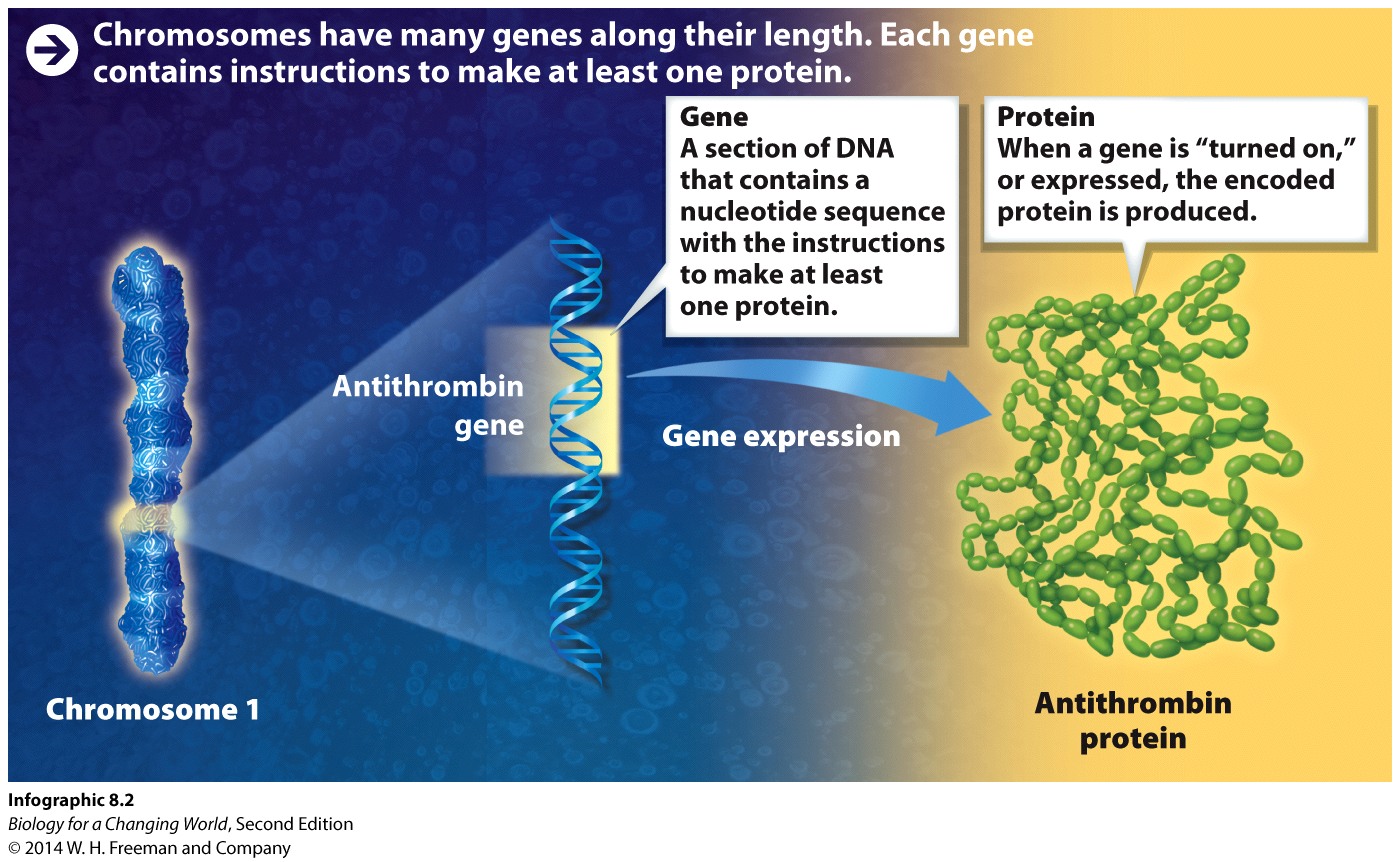
8.
Write one or two sentences that describe your diagram and accurately explain the relationships among these four things.
Define “allele”.
9.
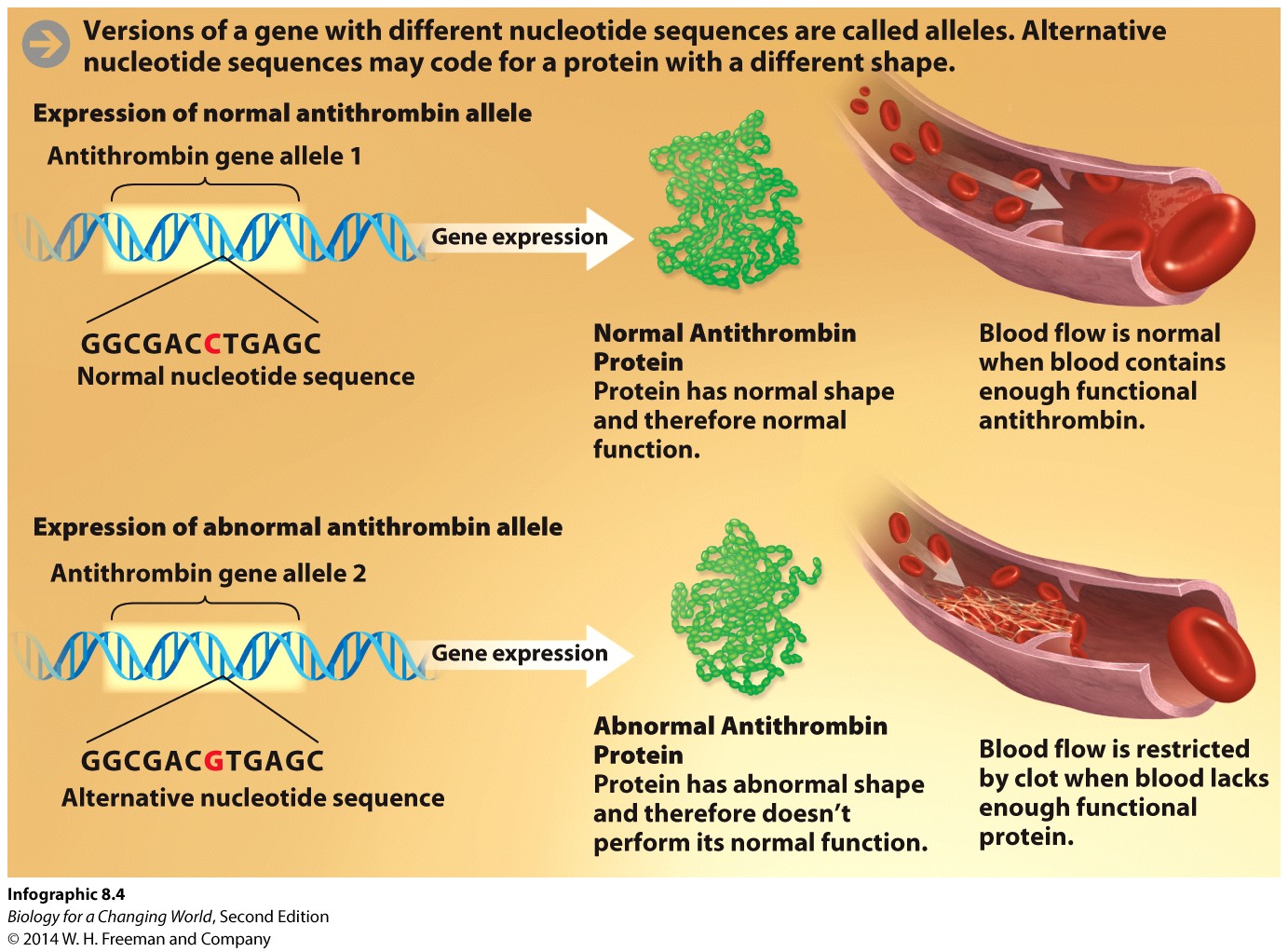
Examine the nucleotide sequences of the two antithrombin alleles in Infographic 8.4. How do they differ?
10.
Using this information, define “allele.”
Explain how differences in alleles can result in different phenotypes.
11.
What specific feature of a protein will be changed if the nucleotide sequence of its gene is changed?
12.
How will this change affect a protein’s three-dimensional structure?
13.
Using your answers, draw a diagram or flow chart, in your notebook, illustrating how two alleles of the same gene can produce two versions of the same protein.
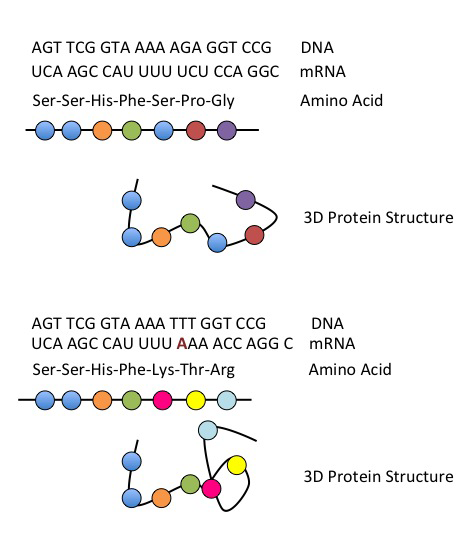
Explain how some alleles may result in non-functional phenotypes.
14.
Based on these principles, how could an allele produce a completely nonfunctional version of its protein?
Review Questions
15.
Changing a protein’s amino acid sequence changes its three-dimensional folding:
| A. |
| B. |
| C. |
| D. |
| E. |
16.
Which of the following best describes the relationship among genes, chromosomes, and proteins?
| A. |
| B. |
| C. |
| D. |
| E. |
Related Vocabulary
17.
Define each term, illustrate as appropriate, and note the similarities and differences between terms.
• Side Group
• Hydrophobic
• Hydrophilic
8.3 Driving Question 2
Driving Question 2
What are the steps of gene expression and where do they occur in a cell?
Why should you care?
Protein production must be carefully regulated so that the right proteins are produced in the right cells at the right time and in the right amounts. This is possible because each gene has two parts: a regulatory sequence and a coding sequence. Harry Meade used this fact of gene structure to develop transgenic goats that produce human antithrombin in their milk. But how was he able to leverage the steps of gene expression to make goats synthesize human proteins? To express a gene—that is, to go from DNA to a functional protein—requires two steps: transcription and translation.
Transcription consists of copying the coding sequence of a gene into a messenger RNA (mRNA) molecule, which can then be used to direct protein synthesis. The details of transcription follow many of the same rules that guide DNA replication. A clear understanding of the relationship between DNA and mRNA is important for understanding the role of mutations in hereditary diseases such as antithrombin deficiency and many forms of cancer.
In translation, instructions from mRNA are used to synthesize proteins. Because this process directly connects DNA instructions with the amino acid sequence of proteins, it is also where we can most directly see the consequences of mutations.
What should you know?
To fully answer this Driving Question, you should be able to:
- Explain gene structure and function in terms of regulatory and coding sequences.
- Define and describe, in overview, the two steps of gene expression (transcription and translation).
- Describe the role of mRNA, in overview, in these two processes.
- Outline and explain of DNA transcription, beginning with the enzyme RNA polymerase binding and ending with the mRNA transcript leaving the nucleus.
- Correctly compose the mRNA sequence that would be transcribed from a sequence of DNA nucleotides.
- Outline and explain of translation, beginning with the arrival of mRNA in the cytoplasm and ending with a functional protein. Be sure to include the roles of ribosomes and transfer RNA (tRNA).
- Define “codon” and “anti-codon”.
- Correctly compose the sequence of a tRNA anticodon that would pair with a sequence of any given mRNA codon.
Infographic Focus
The infographics most pertinent to the Driving Question are 8.2, 8.5, and 8.7 to 8.10.
Test Your Vocabulary
Choose the correct term for each of the following definitions:
| Term | Definition |
|---|---|
| The cellular machinery that assembles proteins during translation. | |
| The RNA copy of an original DNA sequence made during transcription. | |
| A type of RNA that transports amino acids to the ribosome during translation. | |
| The part of a gene that specifies the amino acid sequence of a protein. Coding sequences determine the identity, shape and function of proteins. | |
| The second stage of gene expression during which mRNA sequences are used to assemble the corresponding amino acids to make a protein. | |
| The part of a gene that determines the timing, amount and location of protein production. | |
| The part of a tRNA molecule that binds to a complementary mRNA codon. | |
| The enzyme that carries out transcription. RNA polymerase copies a strand of DNA to a complementary strand of mRNA. | |
| The first stage of gene expression, during which cells produce molecules of mRNA from the instructions encoded in genes in DNA. | |
| The set of rules relating particular mRNA codons to particular amino acids. | |
| A sequence of three mRNA nucleotides that specifies a particular amino acid. |
Explain gene structure and function in terms of regulatory and coding sequences.
18.
Illustrate and name the two components of a gene and describe the function of each.
Define and describe, in overview, the two steps of gene expression (transcription and translation) in a eukaryotic cell.
19.
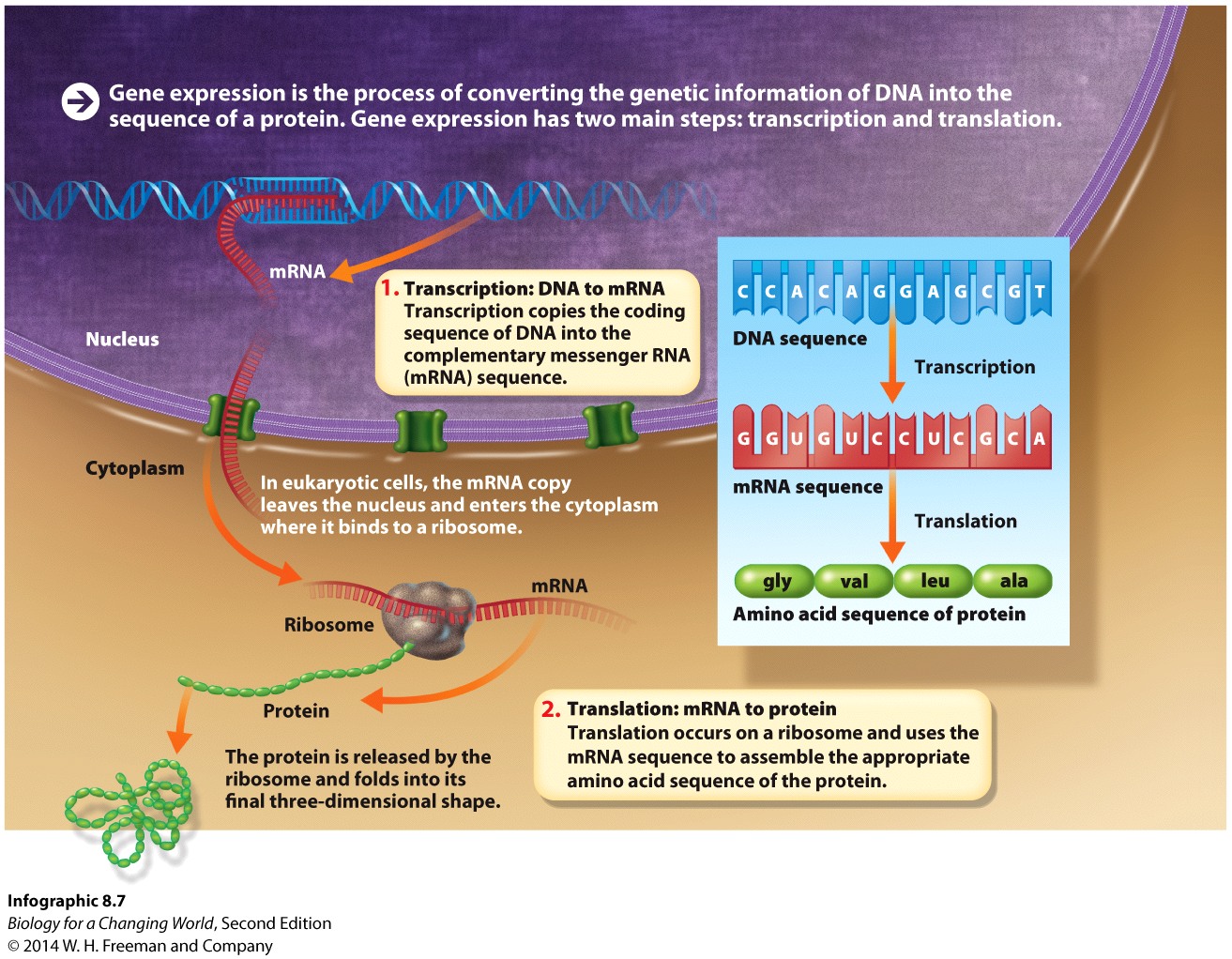
Examine the top part of Infographic 8.7 and name the first step of gene expression.
20.
Where does transcription take place?
21.
What is the template (the molecule from which information is copied) of transcription?
22.
What is the final product of transcription?
23.
Examine the second part of the graphic and name the second step of gene expression.
24.
Where does translation take place?
25.
What is the template of translation?
26.
What is the final product of translation?
Describe the role of mRNA, in overview, in these two processes.
27.
Examine the diagrams of both steps of gene expression. What is the function of mRNA?
Outline and explain the process of DNA transcription, beginning with RNA polymerase binding and ending with the mRNA leaving the nucleus.
28.
Describe the first step in transcription, including the name of the key enzyme and where it binds the DNA.
29.
Describe the second step in transcription. How does RNA polymerase know which RNA nucleotides to add to the growing mRNA chain?
30.
Describe the third step in transcription.
31.
Describe the last step in transcription. Is the DNA (gene) altered as a result of transcription? Explain.
Correctly compose the mRNA sequence that would be transcribed from a sequence of DNA nucleotides.
32.
What mRNA sequence would be transcribed from this DNA sequence?
AATACTCCACGCATTACTTGGGAACCCGGG
33.
How does it differ from the complementary DNA strand to this sequence?
Outline and explain of translation, beginning with the arrival of mRNA in the cytoplasm and ending with a functional protein. Be sure to include the roles of ribosomes and tRNA.
34.
Describe the first step in translation, being sure to define and describe all necessary terms.
35.
Describe the second step in translation. How many nucleotides of mRNA are needed to specify a tRNA and its associated amino acid? How does tRNA know which mRNA sequence to bind to?
36.
Describe the third step in translation. Do tRNAs remain connected to the growing amino acid chain? Explain.
37.
Describe the final step in translation. Is the mRNA strand altered as a result of translation? Why might this be important?
Define “codon” and “anticodon”.
38.
Define and illustrate “codon” and “anticodon.”
Correctly compose the matching tRNA anticodons that would pair with a sequence of mRNA codons.
39.
Write the sequence of tRNA anticodons that would pair with the following mRNA sequence: UUAUGUGGUGCGUAAUGAACCCUUGGGCCC
Correctly compose the sequence of amino acids from the codons of an mRNA.
40.
Write the resulting sequence of amino acids from the translation of the mRNA described in Question 8 (UUAUGUGGUGCGUAAUGAACCCUUGGGCCC).
41.
Based on what you know, does this gene likely encode a functioning protein? Why or why not?
Review Questions
42.
Where in a eukaryotic cell would you find RNA polymerase?
| A. |
| B. |
| C. |
| D. |
43.
From the following DNA sequence, what would be the correct mRNA transcript? DNA sequence = AGTCGCAT
| A. |
| B. |
| C. |
| D. |
44.
What ultimately dictates a protein’s three-dimensional shape?
| A. |
| B. |
| C. |
| D. |
8.4 Driving Question 3
Driving Question 3
How can animals be genetically modified to produce human proteins with therapeutic uses?
Why should you care?
Before Harry Meade developed his methods for producing transgenic goats, large-scale antithrombin production was inefficient to say the least: it takes 50,000 human donors to produce 1 kg of antithrombin. A single transgenic goat, in contrast, can produce that amount in a year, according to GTC Biotherapeutics. In transgenic goats, the human gene of interest is expressed in the mammary glands so that the protein is produced in large quantity in milk. To develop a transgenic goat that would produce a specific foreign protein in only one tissue, Meade took advantage of the two-part structure of genes and the fact that the genetic code is universal.
What should you know?
To fully answer this Driving Question, you should be able to:
- Explain and diagram how a recombinant gene is made.
- Explain how to produce a transgenic goat using a recombinant gene.
- Discuss the mechanism(s) that ensure that the protein of interest (antithrombin, in this case) is produced only in the goat’s mammary glands (and secreted in milk) and not in other tissues.
- Explain the statement “the genetic code is universal” and its significance for developing and using transgenic organisms.
Infographic Focus
The infographics most pertinent to the Driving Question are 8.5 to 8.7 and 8.10.
Test Your Vocabulary
Choose the correct term for each of the following definitions:
| Term | Definition |
|---|---|
| A genetically engineered gene. | |
| The set of rules relating particular mRNA codons to particular amino acids. | |
| Assembling new genes with novel combinations of regulatory and coding sequences. | |
| A treatment that aims to cure human disease by replacing defective genes with functional ones. | |
| The part of a gene that specifies the amino acid sequence of a protein. Coding sequences determine the identity, shape and function of proteins. | |
| An organism that has been genetically altered by humans. | |
| (An organism) carrying one or more genes from a different species. | |
| The part of a gene that determines the timing, amount and location of protein production. |
Explain and diagram how a hybrid gene is created.
45.
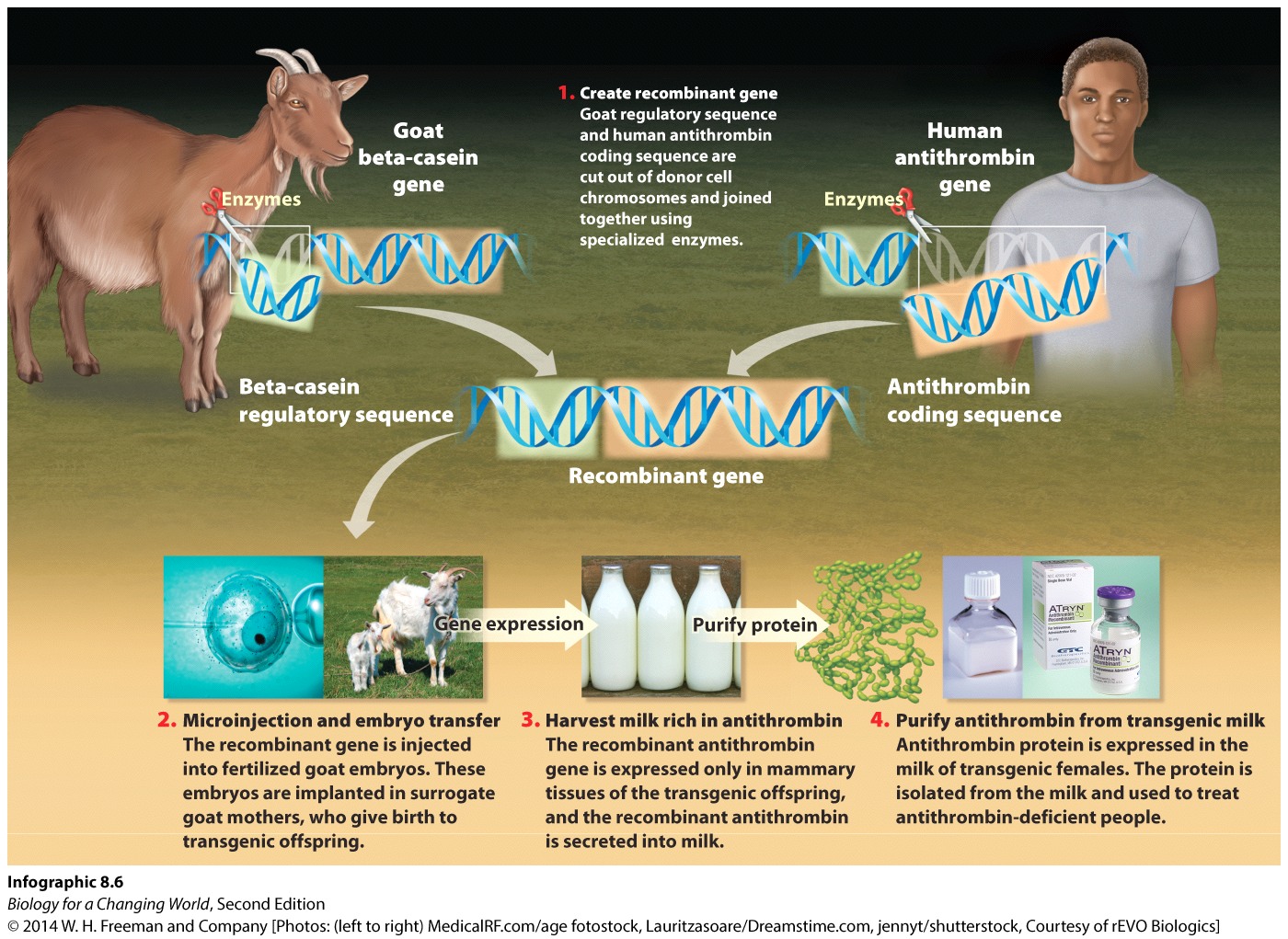
Examine Infographic 8.6. Which two genes, and specifically their parts, are used to produce the hybrid antithrombin gene, and why?
46.
In your notebook, draw a new flow chart or diagram of the process you have just described.
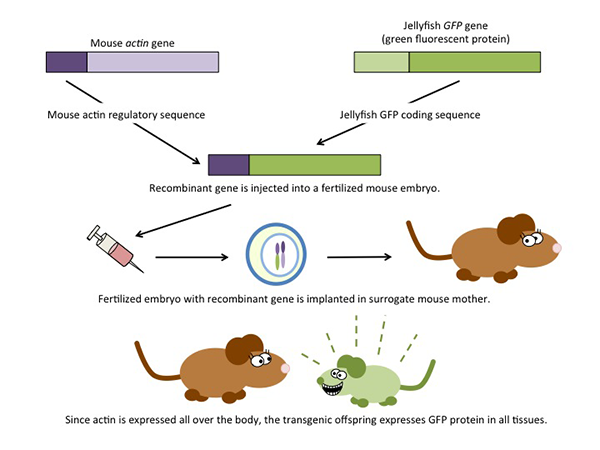
Explain how to produce a transgenic goat using a hybrid gene.
47.
List and describe the two steps used to produce transgenic goats.
Discuss the mechanism(s) that ensure that the protein of interest (antithrombin, in this case) is produced only in the mammary glands (and secreted as milk) and not in other tissues.
48.
When transgenic goats carry the hybrid antithrombin gene, is the gene present in all tissues of the adult goat or only in mammary tissues? Explain.
49.
If the gene is present in all tissues, why is it expressed only in mammary tissues?
Explain the statement “the genetic code is universal” and its significance for developing and using transgenic organisms.
50.
What, specifically, do we mean when we say that the genetic code is universal?
51.
Why is the universality of the genetic code central to our ability to produce transgenic organisms? Or, to put another way, if the genetic code were not universal, could Harvey Meade have used the techniques he did to produce a transgenic goat? Why or why not?
Correctly interpret a DNA sequence to predict the resulting mRNA and protein sequences.
52.
Write the corresponding mRNA sequence beneath the following DNA sequence. Below the mRNA sequence, write the amino sequence of the protein encoded by the DNA and mRNA.
T A C G G G C G G T T C T T A C T C A G G T C C G A G G T G T C T A A A A C T
Protein: Met – Pro – Ala – Lys – Asn – Glu – Ser – Arg – Leu – His – Arg – Phe – Stop
Review Questions
53.
Male goats also have mammary tissue, so why does a transgenic male goat not produce human antithrombin?
| A. |
| B. |
| C. |
| D. |
54.
Hypothetically, if an organism’s genes did not follow the traditional genetic code, the ____________ specified by each codon would be different.
| A. |
| B. |
| C. |
| D. |
55.
True or False: A transgenic goat with a recombinant gene composed of a regulatory region from a human antithrombin gene and the coding region from a goat mammary gland gene would produce a functional therapeutic protein for human disease treatment.
| A. |
| B. |
8.5 Driving Question 4
Driving Question 4
What are some practical applications of genetically modified organisms in treating human disease?
Why should you care?
Goats, pigs, sheep, mice, viruses, plants, and bacteria are just some of the organisms that have been used in biomedical research laboratories to try to understand, prevent, treat, or cure a plethora of human diseases. Diseases such as Alzheimer’s, malaria, AIDS due to HIV infection, dementia, diabetes, and cancer are widespread human maladies, and unfortunately, odds are you have known at least one person who has been afflicted with one of them. Significant progress toward treatment or prevention of these illnesses has been made thanks to the use of genetically modified organisms (GMOs). However, GMOs are also a constant source of controversy in the media. If you understand what GMOs are and how they are used to treat human disease, you will be better able to have meaningful, fact-driven conversations about these organisms and will not have to depend on sensationalized reports in the popular press for information.
What should you know?
To fully answer this Driving Question, you should be able to:
- List and describe two human diseases that are treated with products made by GMOs.
- Explain why GMOs are used in disease treatment and biomedical research.
Infographic Focus
The infographics most pertinent to the Driving Question are 8.3, 8.5, and 8.6.
Test Your Vocabulary
Choose the correct term for each of the following definitions:
| Term | Definition |
|---|---|
| Assembling new genes with novel combinations of regulatory and coding sequences. | |
| An organism that has been genetically altered by humans. | |
| A genetically engineered gene. | |
| (An organism) carrying one or more genes from a different species. |
List and describe two human diseases that are treated with products made by GMOs.
56.
What are two human diseases that are now treated with products made by GMOs? Describe what is deficient in individuals with these diseases, what products are made by the GMO, and which GMO is used.
People with inherited antithrombin deficiency do not produce enough, or any, antithrombin to combat the formation of blood clots. To raise the level of antithrombin in their blood, patients inject antithrombin that was produced by genetically modified goats and isolated from their milk.
People with diabetes either make no insulin (type 1) or not enough insulin (type 2) and thus cannot efficiently get glucose, your body’s energy source, into their cells. This deficiency can be overcome by injection of insulin that was produced by genetically modified bacteria.
Explain why GMOs are used in disease treatment and biomedical research.
57.
What are the benefits of using GMOs in human disease treatment and research?
Review Question
58.
Why do we typically refrain from harvesting therapeutic proteins from humans?
| A. |
| B. |
| C. |
| D. |
Activity results are being submitted...